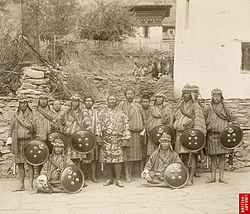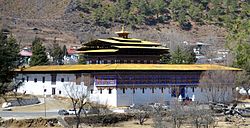- Royal Bhutan Army
-
Royal Bhutan Army Active 1950s – present Country  Bhutan
BhutanType Army Size 6,000 Engagements Operation: All Clear Commanders Commander in Chief GEN Jigme Khesar Namgyel Wangchuck Chief Operations Officer GEN Batoo Tshering Insignia Roundel of Royal Bhutan Army aircraft 
The Royal Bhutan Army (Dzongkha: བསྟན་སྲུང་དམག་སྡེ་; Wylie: bstan-srung dmag-sde),[1] or RBA, is a branch of the armed forces of the Kingdom of Bhutan responsible for maintaining the country's territorial integrity and sovereignty against security threats.[2] The King of Bhutan is the Supreme Commander in Chief of the RBA.[2] The Chief Operations Officer is Goonglon Wogma (Major General) Batoo Tshering.[3][4]
The RBA includes the Royal Body Guards (RBG), an elite branch of the armed forces responsible for the security of the King, the Royal Family, and other VIPs.[5][6]
It is customary, but not obligatory, for one son from each Bhutanese family to serve. In addition, militia may be recruited during emergencies. It may, from time to time, be called on to assist the Royal Bhutan Police (RBP) in maintaining law and order.
Contents
History
The RBA was formed in the 1950s in response to the Chinese take over and subsequent People's Liberation Army actions in Tibet with intense pressure by India. In 1958, the royal government introduced a conscription system and plans for a standing army of 2,500 soldiers.[6] The Indian government had also repeatedly urged and pressured Bhutan to end its neutrality or isolationist policy and accept Indian economic and military assistance. This was because India considered Bhutan its most vulnerable sector in its strategic defense system in regards to China.[7] When Bhutan accepted the Indian offer, the Indian Army became responsible for the training and equipping of the RBA. By 1968, the RBA consisted of 4,850 soldiers, with a recruiting goal of 600 additional soldiers a year. By 1990, the RBA was a force of 6,000 soldiers.[6]
Relationship with the Indian Armed Forces
The Indian Army maintains a training mission in Bhutan, known as the Indian Military Training Team (IMTRAT), responsible for the military training of RBA and RBG personnel.[8] RBA and RBG officers are sent for training at the National Defence Academy (NDA) in Pune, and Indian Military Academy (IMA) in Dehradun.[9]
Project DANTAK of the Border Roads Organisation, a sub-division of the Indian Army Corps of Engineers, has been operating in Bhutan since May 1961. Since then Project DANTAK has been responsible for the construction and maintenance of over 1,500 km of roads and bridges, Paro Airport and a disused airfield at Yangphula, heliports, and other infrastructure.[10] While these serve India's strategic defence needs, it is also an obvious economic benefit for the people of Bhutan.
Army aviation
The Royal Bhutan Army relies on Eastern Air Command of the Indian Air Force for air assistance. In recent years India has helped Bhutan start to develop its military in all areas through military donations and training.[11] Indian Air Force helicopters evacuated RBA casualties to India for treatment during Operation All Clear in 2003.[12]
2003 Operation: All Clear
During the early 90s, the Indian Separatist groups, United Liberation Front of Asom (ULFA), National Democratic Front of Bodoland (NDFB), and Kamtapur Liberation Organization (KLO) had begun to clandestinely set up camps in Bhutan's dense southern jungles. These camps were used to train cadres, store equipment, and launch attacks on targets in India.[13] The Bhutanese government became aware of their presence in 1996 and from 1997, the issue was regularly discussed in the National Assembly.[13][14] The Government of India began exerting diplomatic pressure on the Royal Government to remove the militant presence and offered conducting joint military operations against the militants. The Royal Government preferring a peaceful solution, declined the offer and instead initiated dialogue with the militant groups in 1998.[15] By December 2003, negotiations failed to produce any agreement and the Royal Government unable to tolerate their presence any longer issued a 48-hour ultimatum on 13 December. On 15 December the RBA commenced military operations against the militant groups.[13]
Combat operations
A combined RBA and RBG force of 6,000, operating out of 20 camps established during the six years of negotiations, attacked an estimated 3,000 militants spread across 30 militant camps.[16][17] By 27 December 2003, all 30 militant camps had been captured. Additionally, the RBA seized "more than 500 AK 47/56 assault rifles and 328 other assorted weapons including rocket launchers and mortars, along with more than 100,000 rounds of ammunition. An anti-aircraft gun was also found at the site of the GHQ of the ULFA."[18]
By 3 January 2004, all 30 militant camps (ULFA-14, NDFB-11, KLO-5) with an additional 35 observation posts, were destroyed and the militants dislodged.[19] A total of 485 ULFA, NDFB, and KLO militants were killed, while those captured along with seized weapons and ammunition were handed over to the Government of India. Captured non-combatants were handed over to Assamese civil authorities. The RBA suffered 11 soldiers KIA, and 35 WIA.[12]
Personnel
As of 16 June 2007, the RBA stood at 9,021 active duty personnel. By 2008, this number is expected to be reduced to 8,000 active duty personnel. This is in line with an initiative introduced in 2005 by the Royal Government of Bhutan to reduce the strength of the RBA while increasing militia training of the Bhutanese population.[20]
Army Welfare Project
The Army Welfare Project (AWP) is a commercial enterprise of the RBA set up in 1974 to provide benefits for retired RBA and RBG personnel in the form of employment, pensions, and loans.[6][21] The AWP manufactures alcoholic beverages in three distilleries located in Sarpang, Samdrup Jongkhar and Samtse.[21] As of 2001, the AWP was annually producing 8 million litres of alcoholic beverages of which 60 percent was consumed by the local market and the rest exported to India.[22] Its most popular brand is the Black Mountain Whisky.[21]
Equipment
The RBA is a mobile infantry force lightly armed with weapons largely supplied by India.
Pistols
Assault rifles
- AK-101 (2001)[23]
- AK-104 (2001)[23]
- INSAS rifle
- FN FAL (RFI SLR)
- Heckler & Koch G3
Infantry support weapons
- 81mm Mortar
Ranks
In 1991, the following were the ranks within the Bhutanese Army:[24]
Bhutanese Rank Rank Goongjey Field Marshal Maksi Goong General Goonglon Lieutenant General Goonglon Wogma Major General Dozin Wangpon Brigadier General Maksi Gom Colonel Maksi Wom Lieutenant Colonel Lingpon Major Chipon Captain Deda Gom Lieutenant Deda Wom Second Lieutenant Dimpon Gom Warrant Officer Dimpon Wom Sergeant Major Pelpon Sergeant Peljab Corporal Gopa Lance corporal Chyuma Private See also
References
- ^ "༈ རྫོང་ཁ་ཨིང་ལིཤ་ཤན་སྦྱར་ཚིག་མཛོད། ༼བསྟ༽ [Dzongkha-English Dictionary: "BSTA"]". Dzongkha-English Online Dictionary. Dzongkha Development Commission, Government of Bhutan. http://www.dzongkha.gov.bt/online/dictionaries/dz-en-dict/Contents/09-13-BSTA.html. Retrieved 2011-11-01.
- ^ a b "The Constitution of the Kingdom of Bhutan" (PDF). Government of Bhutan. 2008-07-18. http://www.constitution.bt/TsaThrim%20Eng%20(A5).pdf. Retrieved 2011-11-01.
- ^ "Dozin Batoo Tshering takes over as COO of RBA". Kuensel. 2 November 2005. http://www.kuenselonline.com/modules.php?name=News&file=article&sid=6201. Retrieved 2008-10-22.
- ^ "Eastern Commander visits Bhutan". Kuensel. 20 September 2008. http://www.kuenselonline.com/modules.php?name=News&file=article&sid=11175. Retrieved 2008-10-29.
- ^ The World Factbook. Central Intelligence Agency. 2008. ISBN ISSN 1553-8133. https://www.cia.gov/library/publications/the-world-factbook/geos/bt.html.
- ^ a b c d Nepal and Bhutan : country studies. Washington, D.C.: Federal Research Division, Library of Congress. 1993. p. 424. ISBN 0844407771. http://hdl.loc.gov/loc.gdc/cntrystd.bt.
- ^ Mathou, Thierry (2004). "Bhutan-China Relations: Towards a New Step in Himalayan Politics" (PDF). First International Seminar on Bhutan Studies (Centre for Bhutan Studies): 388–411. http://www.bhutanstudies.org.bt/pubFiles/19-Spdr&Pglt.pdf. Retrieved 2008-10-22.
- ^ "Indian Military Training Team (IMTRAT), Bhutan". Indian Army. Archived from the original on 2009-05-09. http://web.archive.org/web/20090207021230/http://indianarmy.nic.in/index_imtrat.htm. Retrieved 2011-11-01.
- ^ Choden, Tashi (Winter 2004). "Indo-Bhutan Relations Recent Trends" (PDF). Journal of Bhutan Studies (Centre for Bhutan Studies) 11 (6): 112–118. http://www.bhutanstudies.org.bt/pubFiles/v11-6.pdf. Retrieved 2011-11-01.
- ^ "Dantak". Border Roads Organisation. Government of India. http://www.bro.nic.in/indexmain.asp?projectid=23. Retrieved 2011-11-01.
- ^ Dorji, Kinley (March 2004). "Eastern air command chief visits Bhutan". Kuensel. http://www.kuenselonline.com/modules.php?name=News&file=article&sid=1576. Retrieved 2008-10-22.
- ^ a b "A Nation Pays Tribute". Kuensel online. 2004-08-15. http://www.kuenselonline.com/modules.php?name=News&file=article&sid=4394. Retrieved 2011-11-01.
- ^ a b c "The Militant Problem". Kuensel online. 2003-12-15. http://www.kuenselonline.com/modules.php?name=News&file=article&sid=3552. Retrieved 2008-10-24.
- ^ Penjore, Dorji (Summer 2004). "Security of Bhutan: Walking Between the Giants" (PDF). Journal of Bhutan Studies (Centre for Bhutan Studies) 10 (9): 108–131. http://www.bhutanstudies.org.bt/pubFiles/v10-9.pdf. Retrieved 2011-11-01.
- ^ "Resolving the Militant Problem". Kuensel online. 15 December 2003. http://www.kuenselonline.com/modules.php?name=News&file=article&sid=3551. Retrieved 2008-10-27.
- ^ Dorji, Kinley (2003-12-20). "Security Troops Continue Operations to Flush Indian Militants out of Bhutan". Kuensel online. http://www.kuenselonline.com/modules.php?name=News&file=article&sid=3571. Retrieved 2008-10-29.
- ^ "Last Option?". Kuensel online. 2003-11-22. http://www.kuenselonline.com/modules.php?name=News&file=article&sid=3482. Retrieved 2008-10-29.
- ^ Dorji, Kinley (27 December 2003). "Protecting mutual concerns and interests". Kuensel online. http://www.kuenselonline.com/modules.php?name=News&file=article&sid=3588. Retrieved 2008-10-29.
- ^ "RBA Makes Good Progress in Flushing Out Operations". Kuensel online. 2004-01-03. http://www.kuenselonline.com/modules.php?name=News&file=article&sid=3599. Retrieved 2011-11-01.
- ^ Dema, Tashi (2007-06-15). "Militia Should Start in 2008". Kuensel online. http://www.kuenselonline.com/modules.php?name=News&file=article&sid=8607. Retrieved 2011-11-01.
- ^ a b c Wangchuk, Rinzin (17 January 2001). "AWP Distillery Enhances Production". Kuensel online. http://www.kuenselonline.com/modules.php?name=News&file=article&sid=2405. Retrieved 2008-10-30.
- ^ Wangdi, Kencho (6 January 2001). "The growing problem of alcohol: is there an answer?". Kuensel. http://www.kuenselonline.com/modules.php?name=News&file=article&sid=2367. Retrieved 2008-10-30.
- ^ a b "Identified Contracts on Delivery of Russian Arms and Military Equipment, concluded in 2001". Eksport Vooruzheniy (2001-2002)/Moscow Defense Brief (Centre for Analysis of Strategies and Technologies) 1 (1). 2002. http://mdb.cast.ru/mdb/1-2002/ff/icdrame/. Retrieved 2008-11-02.
- ^ Worden, Robert L. "Appendix A. Table 33. Bhutan: Ranks in the Royal Bhutan Army, 1991". Bhutan: A country study (Savada, Andrea Matles, ed.). Library of Congress Federal Research Division (1991).
 This article incorporates text from this source, which is in the public domain.
This article incorporates text from this source, which is in the public domain.
External links
- "༄༅། བསྟན་སྲུང་དྲག་པོའི་ལྟེ་བ།། – Royal Bhutan Army". Royal Bhutan Army online. http://www.rba.gov.bt. Retrieved 2011-11-09.
Categories:- Military of Bhutan
- Armies by country
- Military units and formations established in 1950
Wikimedia Foundation. 2010.


